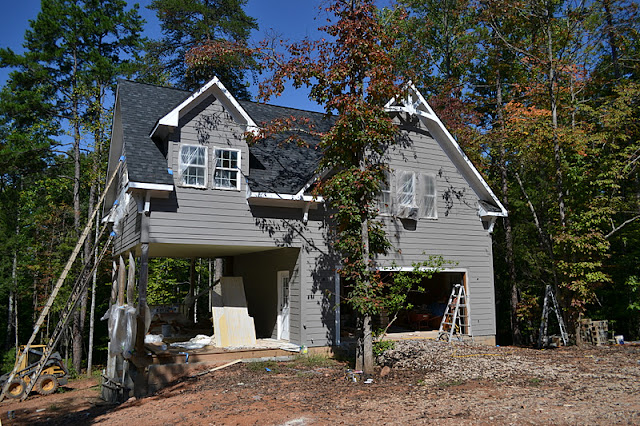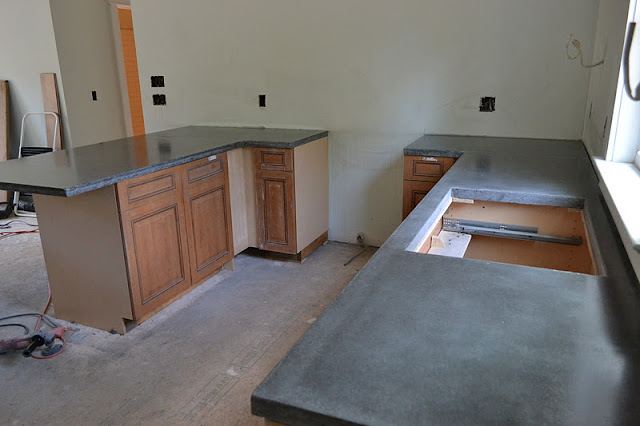After gaining lots of experience with
tiling the shower, I knew it would be a piece of cake to tile the floor. It really didn't intimidate me at all. The only hard part was deciding on WHAT tile to use.
I quickly narrowed down the options at Home Depot (the selection is the same as Lowes, but prices are a tiny bit cheaper at Home Depot). First, I picked out a 12x12in tile that was in the $1 range (aka the cheapest). I don't like tan or beige. Gray is the new beige, didn't you know? I found a dark gray tile with bits of brown in it to warm it up.

Since our bathroom is only 30 sq ft (even smaller once the vanity is added), to buy a slightly more expensive tile only increased the total tile cost by $30. So I picked out a second option. Vintage black and white tile. I LOVE the look of this tile and have so many inspiration photos with tile like this.

Problem was, I didn't love it in our bathroom. It looks too busy to me with the gray lines of grout in the shower. Also, the grout with this tile would have to be white and I really liked the idea of having dark grout to hide dirt with the other tile. Too much going on for a small bathroom.
So the dark 12x12 in tile wins. It has so many things going for it: cheaper, hides dirt, easier to install, less grouting to do, looks more clean and simple.
The first step to tiling was to clear the room of all my supplies. Then, shop vac the floor to remove dirt and dust. Then cut the underlayment (concrete hardiboard) to fit and use thinset to set it in place.


One last chance to change my mind. Nope, still going with the dark one.

Next step was to dry fit the tile. I didn't have this luxury when I tiled the shower walls, due to gravity. First, I laid them out in straight lines, parallel to the wall.

Then I tried it diagonally (which is what I originally wanted, but I just wanted to review all my options).

So, so much better. Diagonal lines trick the eye and make the room seem larger (true story). I think it also looks more professional.
Only question was, can our wet saw cut tile that is 17 long (length of the diagonal cut threw the middle of the 12 in. tile)?

At first it didn't seem so. The silver bar on the left is the guide bar that can be set to a specific measurement. I used this a lot when doing the
shower tile. The black attachment is used to cut a 45 degree angle, which is what we need on the 12in. floor tiles.
Hopefully, you can see how the corner of the tile can't fit into the black attachment and also have the saw blade meet up with the middle line. I feared this meant I couldn't lay them in a diagonal pattern if I had no way to cut them.
Turns out you can just remove the guide edge and attachment and just feed the tile into the blade free handed. The saw is not actually on here. When it's on, it sprays a mist of water all over you (dirty water).

It might not have been a perfect cut, but all the cut edges will be hidden by caulk or wood baseboards.
Irregular and curve cuts are much less simple. That's where tile nippers come into hand.

How in the world do you cut around a door frame? Well, you make a template. Once your template matches up, trace it onto your tile.

Then you're going to make a series of parallel cuts in the area that you're trying to remove (stopping at the lines you drew). I borrowed this picture since I couldn't really take a picture of myself doing it.

Then use the tile nippers and nip away the "sticks" of tile. (Another borrowed picture.)

Tile nippers can be use "free handed" without a wet saw. I did this a lot around plumbing fixtures, only because it will be fully hidden after the fixtures are installed. Tile nippers by themselves don't leave a clean line.
The first day I dry fitted half of the floor. There should be tile spacers in between each one to insure a perfect fit, but the ones I bought I decided were too big. So I took them back and bought 3/16 in. spacers instead of 1/4 in. spacers.

Here is where it is important to step back and take a look at your work so far. I almost forgot to mix up the tile from box to box. Each box might come from different batches and the patterns will look different (and mine really did!). As long as you mix them up randomly on the floor, it will look natural. You don't want to use an entire box for the first few rows, then switch to a different box and have it look totally different.
Let's take another look at the first section that was already dry fit.

Those tiles outlined are from a different box. They are more splotchy and brown. I didn't notice until I stood up and then it was glaringly obvious. I'm so glad they weren't adhered down yet!
Now you can add your tile spacers.

After everything was dry fit, I started applying tile adhesive to the back of each tile, one at a time. I prefer this method to applying adhesive to a large area and then placing the tiles back on. This method is neater and more precise.

After waiting at least 24 hrs for the adhesive to cure, it's time to grout. I picked out "Sahara Beige". It's as dark as the tile and is also a warm gray. This is really a personal preference, but most people don't want the grout to stand out. The tile is the expensive part and the pretty part, so you want that to take center stage. You do that by picking a grout that "disappears" the best when held against the tile.

When I went to Lowes to buy the grout, they didn't have the small bag of it in stock. They only had large bags. I didn't even need the whole small bag because our room is so small. The Lowes guy was helping me look for the color and he went to check their stack of bags with holes (typically unsellable). He found a large bag of sahara beige with a hole in it. They regularly sell for around $13, but he said he could give me the holey back for $1. Um, yes please! I'll be putting a hole in it in about an hour. And he bagged it in plastic to keep our car clean.
Mixing the grout is really easy. You just add water until it's the consistency of a Wendy's frosty (I've heard this comparison from lots of people). Use a grout float to help squish it into the grooves.
Then, get a large bucket of water and large cleaning sponge. Use a clean sponge to wipe up the excess grout from the tile. Wipe, rinse sponge out, and wipe again.
Work your way out the door so you don't get trapped.

If you have them, knee pads are a life saver!!

Here it is done, and still wet. After it's dry, come back and sponge off the grout residue (call "grout haze") from the tiles one last time.

And here it is dry:

If you are thinking what I am thinking, then you think the grout dry much lighter than you expected. Once again, here is the color of the sample.

That does NOT match.
If you ask me, the grout looks more like this one and the one above it.

Not much I can do about it now. I've heard you can get grout stain, but I'm not going to worry with it yet. Maybe it will darken with use (aka dirt). Although I did apply grout sealer to help prevent too much staining.
And there you have it. The floor is done. A few remaining details like caulking along the wall and tub are not shown yet, but you get the idea.






























































